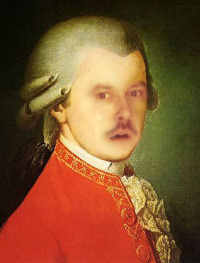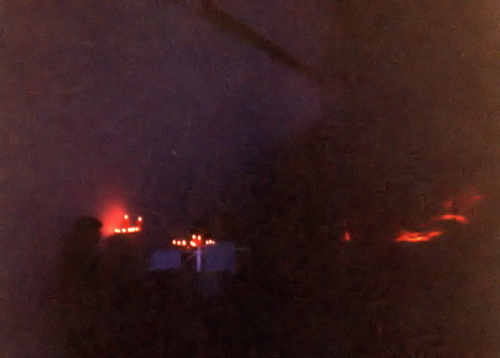A 365-Day Project
"We Are All Mozart"
A project to create
new works and change
the perception of the
music of our time.


 July 3, 2006
July 3, 2006 
Music. Electroacoustics. Sound Art. Three outwardly diverging directions of nonpop -- or inwardly converging ones, or intertwined strands.
Because my indiscriminate listening has involved all three since the early 1960s and my indiscriminate composition has involved all three since the early 1970s, the distinctions had never been in any particular need of articulation. Sound could take any distorted shape behind my eyes and ears. All simply were. And as a record-jacket musicologist, I could find readymade terms to describe my work to others when called upon.
But the need to know has arrived.
The issue has come up now because a (re-)(en)trenchment is taking place among a younger generation of composers, encouraged by an internet where people can come together from far-flung geographies into virtual space to create interest groups. Alas, rather than an expansive interplay of ideas, every day greets the formation of another "looping artful sound in space" or "biblical basic jungian notochord" or "genetic ringtone sub-algorithms" newsgroup or mailing list. Each devoted congregation is developing a specialized vocabulary using the same words, and within some sound discussions, an artistic political correctness prevails.
So for me a reflection on music, electroacoustics, and sound art is helpful. They overlap. Some think of them as a hierarchy or intersecting sets. But what are they in practice, and are such distinctions valid? Though to every point of definition can be brought an argument against, divergent directions are still worth considering.
The three directions are sound as patterned events (music), sound as events in space (electroacoustics), and sound events as living space (sound art). Respectively, the three are also audience-distant, audience-proximate, and audience-involved. They sometimes -- even often -- involve different kinds and levels of listening. The three directions have many committed practitioners who do not cross the line from one into the other. And finally and least important, the three directions have myriad theories and schools of thought. (I place it least important because making art leads to talking about art.)
It may seem at first that these are all the same, or one could be described in terms of another. Yes, such mélanges are possible, but outside a deconstructed world, it is also possible to get beyond the wordless "know it when you hear it" oh-wow response. It would seem this contradicts my previous comments about avoiding words when being involved with art. But words used to describe the processes (into and out of) the sonic art, not a particular work of art, can be engaging. This distinction is crucial because (to reiterate) an artwork only speaks in its own language, but art can be spoken of categorically. And yes, this commentary will crumble under the pressure of analysis. But enough justificational shimmies. Back to the three directions of nonpop.
Characteristics
The characteristics of music are the most well known if ill-described. It is an assembly of pitches traveling through time, usually organized into cells of relationships (tonality, dodecaphony, modality...) and placement (beats, bars, modules...), modified by overlap (harmony, counterpoint, verticality...) and color (instruments, voices, noises...), and having a shape or direction. Music is historically expressive, and today inhabits a world between the virtual and the physical. Its experiment is in changing extant individual relationships to patterned sound and forming an expressive worldview. Its audience is placed away from the sound source, and engages in historical and social listening expectations, as well as sometimes extra-musical elements of emotion (how playing affects me), personality (who is playing), and mechanics (what is played). Listening can be foreground or background, calling on significant acculturated behavior for the latter.
By contrast, electroacoustics, a field with fractious practitioners, is made of sound in space (objects, processes, movement...) that attempts textural innovation (invention, transformation, recontextualization...) and is sound-centric. It travels through time with declarification (known, unknown, perceived, imagined...) and carries few historical anticipations. With present technology, electroacoustics must always inhabit the world of the virtual. Its experiment is in transforming the relationship to sound itself and forming a diffractive worldview. Its audience is dominantly ear-oriented, and proximate to the experience (diffusion) or almost inside it (headphones). Nonpop electroacoustics engages in a particular challenge with respect to audiences that are either élite or general -- the former often with strong formed opinions, the latter with little experience and few expectations. Listening is foreground, calling for focused attention.
The defining condition of sound art is its bond to the physical environment, employing music and electroacoustics as well as natural processes and physical objects to create an inevitability of experience across time and space. Though it uses music and electroacoustics, its sum total is more than and different from either. Its soundworld is space-aligned and, most significantly, it is audience-involved. With the exception of passive sound sculpture, sound art inhabits the world in which the audience is being. It is uncertaincy made manifest, as the audience's position and motion are not consequences of a concert but integral parts of the experience. To move is to change the creation itself, so sound art's experiment is in transforming the world of sound and space, sound in space. Its audience is self-presenting. Listening is foreground and background at once, that is, intrinsic and ineluctable.
The quality of interaction differs significantly among the three, giving rise to confusion about intent (sender) and meaning (receiver). With music, interaction is from audience to performer in a bio-presentational feedback (but not via the artwork); there is no significant interaction with recordings other than the primitive acts of starting, stopping, and volume. Electroacoustics, much like concerts and recordings, offers little to no interaction, the particular exception being invited (direction: out) or inadvertent/self-actualized (direction: in) interaction, the latter à la sound sculpture. Because sound art is action in sound and space, participation is inevitable whenever someone (or even something) moves into the space -- an intervention in the artwork.
To elaborate on that last: Perception of or intervention in sound art might not necessarily be evident, particularly in the present, where the people moving into the domain of the sound artwork may not be made (or become) aware that the artwork has transformed itself for and by them. In fact, it might even combine the obvious (motion) and the subtle (historical shift) -- as in, for example, In Bocca al Lupo. It may also be acoustic and "unpresent", as in an external installation such as a windharp or similar environmental sound art, so that interaction (if it comes into being) is entirely inadvertent but, once perceived, moves toward the deliberate. Wind and weather participate in the creation of its (and its visitor's) history.
Where music, electroacoustics or sound art phase together, it is the zonule of nexus, the adulteration of purity, and the most compelling -- for it is at the borders of uncertainty.
Rickmansworth
There is a temptation to explain these differences scientifically. Neurons rule. In replicating the real world, acousticians use mathematics and experiment to create an emulation of existing reality. This is rarely the goal of art in modern times, whose creators understand art as an additional level of translation and abstraction of reality superimposed upon that accomplished by the senses alone. All three are experiments. But these experiments, these artworks, are bound to fail. All art fails. If it didn't fail, we would stop making it. Failure is the crack into which new seeds drop and sprout.
But those neurons. Those mirror neurons. What are the gestures that the audience imitates in music, electroacoustics, and sound art? All three are at best heavily abstracted. Are there implied gestures? Manfred Clynes advocates that they exist in music, that simple gestures of pitch are commonplace in all languages and all musics. And the imitative sense in electroacoustics, concerned as it is with creation, transformation and, as in musique concrète, disguise? Is it too far abstracted? And sound art, which may mix the real and the unreal, the clear and the transformed, the true and the false: How do the mirror neurons respond?
In other words, do these artforms act on or act with their receivers, their audiences?
This really isn't diverging as far from the original topic as it might seem. When artists create sound works ("when composers compose"), they may wish to deny an intended audience. Some claim that audience is not only impossible to know, but diminishes the scope of the imagination. That's reasonable. But the fixation of an artwork into some form implies its use (and no, this won't become a treatise on the free market), meaning some consideration of that use is taken into account during the making of the art.
What different audiences, then, do we imagine when creating music vs. electroacoustics vs. sound art? What directions do we take, what choices do we select under that influence? What techniques do we choose, what references do we make? What appeals do we incorporate (passion/emotion, intellect, state of being, physicality)? How do these choices differ, depending on how many of the ten audiences we accept or reject?
Ah. That's where I was going, and have just discovered it. Three sonic artforms diverging and converging and intertwining at the borders of uncertainty where there is diaphanous interaction with ten differently characterized receiver audiences. (Though I might be feeling like the Hitchhiker's Guide Rickmansworth café girl.** right now...)
The purity of music, electroacoustics, and sound art are ultimately dull as angels. Rabelais (mon semblable, mon frère) taught long ago that the hell of imperfection is the humanity's natural community.
Your turn.
**"And then, one Thursday, nearly two thousand years after one man had been nailed to a tree for saying how great it would be to be nice to people for a change, one girl sitting on her own in a small café in Rickmansworth suddenly realized what it was that had been going wrong all this time, and she finally knew how the world could be made a good and happy place. This time it was right, it would work, and no one would have to get nailed to anything. Sadly, however, before she could get to a phone to tell anyone about it, a terribly stupid catastrophe occurred, and the idea was lost forever."

Performance version of Zonule Glaes II for string quartet & electronics, at the Mánes Museum in Prague, 1999. The sound art version was without string quartet, and ran from inside a massive lead-faced structure.